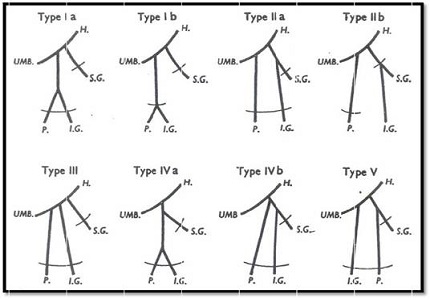A study on internal iliac artery branching pattern and its clinical significance
Abstract
Background: The internal iliac artery is the artery of the pelvis. It supplies most of the blood to the pelvic viscera, gluteal region, medial thigh region and perineum. Injuries of internal iliac artery and its severe bleeding are more common which leads to potentially lethal complication in pelvic surgeries. While operating on pelvic organs, the knowledge of internal iliac artery, its branching pattern and its variations is important for surgeons.
Objectives: The present study conducted to study the branching pattern of internal iliac artery by dissection method and to study the variations in the branching pattern. Materials and
Methods: Dissection of 50 adult human pelvic halves was procured from embalmed cadavers of J.J.M. Medical College and S.S.I.M.S & R.C, Davangere for the study.
Results: The classification of branching pattern of internal iliac artery was based on modified Adachi classification. Out of the 50 specimens studied, Type Ia arrangement was found in 52% of the specimens, Type III in 34%, Type IIa and type V was found in 2% each, Type IV was not found in any of the specimens and 10% of the specimens could not be classified because of the absence of inferior gluteal artery in them.
Conclusion: Adachi Type Ia arrangement was the most frequent finding. The obturator artery took origin most frequently from the anterior division of internal iliac artery. Middle rectal artery was not constant.
Downloads
References
2. Pai MM, Krishnamurthy A, Prabhu LV, Pai MV, Kumar SA and Hadimani GA. Variability in the origin of the obturator artery. ClinicsBasic Research 2009; 64(9): 897-901. doi: 0.1590/S1807-59322009000900011. [PubMed]
3. Carrel A. Suture of blood-vessels and transplantation of organs. In: Nobel Lectures, Physiology or Medicine 1901-1921. Amsterdam: Elsevier Publishing Company, 1967. http://nobelprize.org/medicine/laureates/1912/carrel-lecture.html. Accessed July 29, 2005.
4. Jastschinski, S. Die typischen Verzweigungsformen Der Arteria hypogastrica. Int. Mschr. Anat. Physiol. 1891(a): 8;111-127.
5. Adachi, B. Das Arteriensystem der Japaner, Bd. II. Kyoto. Supp. To Acta Scholae Medicinalis Universitatis Imperalis in Kioto, 1928;9:1926-7.
6. Lipschutz B. A composite study of the hypogastric artery and its branches. Ann Surg 1918; 67(5): 584-608. [PubMed]
7. Bleich AT, Rahn DD, Wieslander CK, Wai CY, Roshanravan SM and Corton MM. Posterior division of internal iliac artery: anatomic variations and clinical applications. Am J Obstet Gynecol 2007;197(6):658. DOI: 10.1016/j.ajog.2007.08.063.
8. Bergman RA, Thompson SA, Afifi AK and Saadeh FA. Compendium of human anatomic variation. Baltimore and Munich: Urban and Schwazenberg; 1988 .p.84-85.
9. Braithwaite JL. Variations in origin of the parietal branches of the internal iliac artery. J Anat. 1952 Oct; 86(Pt 4): 423–430. PMCID: PMC1273694.
10. Yamaki K, Saga T, Doi Y, Aida K, Yoshizuka M. A statistical study of the branching of the human internal iliac artery. Kurume Med J. 1998;45(4):333-40. [PubMed]
11. Roberts WH, Krishingner GL. Comparative study of human internal iliac artery based on adachi Classification. The Anatomical Record 2005;158(2):191-96. DOI: 10.1002/ar.1091580208.
12. Pick JW, Anson BJ and Ashley FL. The origin of the obturator artery.Am J Anat 1942;70:317-43.
13. Kumar D and Rath G. Anamolous origin of obturator artery from the internal iliac artery - A case report. Int J Morphol 2007;25(3):639-41.
14. Reddy S, Vollala VR and Rao M. Absence of inferior gluteal artery : a rare observation. International Journal of Morphology 2007;25(1):95-98.
15. Havaldar PP, Taz S, Angadi AV, Saheb SH. Morphological study of obturator artery. Int J Anat Res. 2014;2:354–7.
16. Havaldar PP, Taz S, Angadi AV, Saheb SH. Study of posterior division of internal iliac artery. Int J Anat Res. 2014;2(2):375-9.
17. Pavan P Havaldar et al. Study of medial circumflex artery. Int J Anat Res.2014; Vol 2(2):380-82.



 OAI - Open Archives Initiative
OAI - Open Archives Initiative


















 Therapoid
Therapoid

